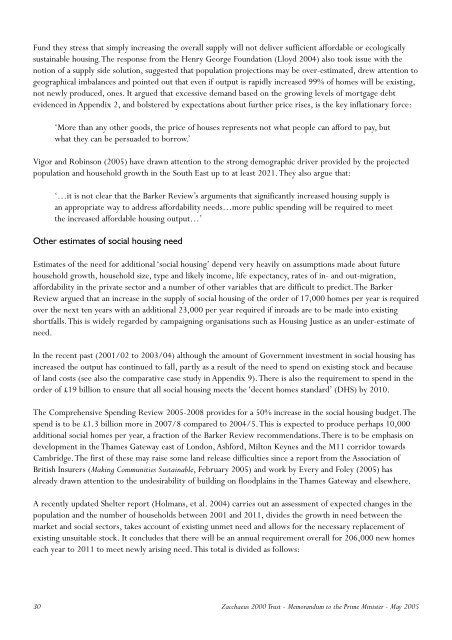Memorandum-to-the-Prime-Minister-on-Unaffordable-Housing
Memorandum-to-the-Prime-Minister-on-Unaffordable-Housing
Memorandum-to-the-Prime-Minister-on-Unaffordable-Housing
You also want an ePaper? Increase the reach of your titles
YUMPU automatically turns print PDFs into web optimized ePapers that Google loves.
Fund <str<strong>on</strong>g>the</str<strong>on</strong>g>y stress that simply increasing <str<strong>on</strong>g>the</str<strong>on</strong>g> overall supply will not deliver sufficient affordable or ecologically<br />
sustainable housing.The resp<strong>on</strong>se from <str<strong>on</strong>g>the</str<strong>on</strong>g> Henry George Foundati<strong>on</strong> (Lloyd 2004) also <str<strong>on</strong>g>to</str<strong>on</strong>g>ok issue with <str<strong>on</strong>g>the</str<strong>on</strong>g><br />
noti<strong>on</strong> of a supply side soluti<strong>on</strong>, suggested that populati<strong>on</strong> projecti<strong>on</strong>s may be over-estimated, drew attenti<strong>on</strong> <str<strong>on</strong>g>to</str<strong>on</strong>g><br />
geographical imbalances and pointed out that even if output is rapidly increased 99% of homes will be existing,<br />
not newly produced, <strong>on</strong>es. It argued that excessive demand based <strong>on</strong> <str<strong>on</strong>g>the</str<strong>on</strong>g> growing levels of mortgage debt<br />
evidenced in Appendix 2, and bolstered by expectati<strong>on</strong>s about fur<str<strong>on</strong>g>the</str<strong>on</strong>g>r price rises, is <str<strong>on</strong>g>the</str<strong>on</strong>g> key inflati<strong>on</strong>ary force:<br />
‘More than any o<str<strong>on</strong>g>the</str<strong>on</strong>g>r goods, <str<strong>on</strong>g>the</str<strong>on</strong>g> price of houses represents not what people can afford <str<strong>on</strong>g>to</str<strong>on</strong>g> pay, but<br />
what <str<strong>on</strong>g>the</str<strong>on</strong>g>y can be persuaded <str<strong>on</strong>g>to</str<strong>on</strong>g> borrow.’<br />
Vigor and Robins<strong>on</strong> (2005) have drawn attenti<strong>on</strong> <str<strong>on</strong>g>to</str<strong>on</strong>g> <str<strong>on</strong>g>the</str<strong>on</strong>g> str<strong>on</strong>g demographic driver provided by <str<strong>on</strong>g>the</str<strong>on</strong>g> projected<br />
populati<strong>on</strong> and household growth in <str<strong>on</strong>g>the</str<strong>on</strong>g> South East up <str<strong>on</strong>g>to</str<strong>on</strong>g> at least 2021.They also argue that:<br />
‘…it is not clear that <str<strong>on</strong>g>the</str<strong>on</strong>g> Barker Review’s arguments that significantly increased housing supply is<br />
an appropriate way <str<strong>on</strong>g>to</str<strong>on</strong>g> address affordability needs…more public spending will be required <str<strong>on</strong>g>to</str<strong>on</strong>g> meet<br />
<str<strong>on</strong>g>the</str<strong>on</strong>g> increased affordable housing output…’<br />
O<str<strong>on</strong>g>the</str<strong>on</strong>g>r estimates of social housing need<br />
Estimates of <str<strong>on</strong>g>the</str<strong>on</strong>g> need for additi<strong>on</strong>al ‘social housing’ depend very heavily <strong>on</strong> assumpti<strong>on</strong>s made about future<br />
household growth, household size, type and likely income, life expectancy, rates of in- and out-migrati<strong>on</strong>,<br />
affordability in <str<strong>on</strong>g>the</str<strong>on</strong>g> private sec<str<strong>on</strong>g>to</str<strong>on</strong>g>r and a number of o<str<strong>on</strong>g>the</str<strong>on</strong>g>r variables that are difficult <str<strong>on</strong>g>to</str<strong>on</strong>g> predict.The Barker<br />
Review argued that an increase in <str<strong>on</strong>g>the</str<strong>on</strong>g> supply of social housing of <str<strong>on</strong>g>the</str<strong>on</strong>g> order of 17,000 homes per year is required<br />
over <str<strong>on</strong>g>the</str<strong>on</strong>g> next ten years with an additi<strong>on</strong>al 23,000 per year required if inroads are <str<strong>on</strong>g>to</str<strong>on</strong>g> be made in<str<strong>on</strong>g>to</str<strong>on</strong>g> existing<br />
shortfalls.This is widely regarded by campaigning organisati<strong>on</strong>s such as <strong>Housing</strong> Justice as an under-estimate of<br />
need.<br />
In <str<strong>on</strong>g>the</str<strong>on</strong>g> recent past (2001/02 <str<strong>on</strong>g>to</str<strong>on</strong>g> 2003/04) although <str<strong>on</strong>g>the</str<strong>on</strong>g> amount of Government investment in social housing has<br />
increased <str<strong>on</strong>g>the</str<strong>on</strong>g> output has c<strong>on</strong>tinued <str<strong>on</strong>g>to</str<strong>on</strong>g> fall, partly as a result of <str<strong>on</strong>g>the</str<strong>on</strong>g> need <str<strong>on</strong>g>to</str<strong>on</strong>g> spend <strong>on</strong> existing s<str<strong>on</strong>g>to</str<strong>on</strong>g>ck and because<br />
of land costs (see also <str<strong>on</strong>g>the</str<strong>on</strong>g> comparative case study in Appendix 9).There is also <str<strong>on</strong>g>the</str<strong>on</strong>g> requirement <str<strong>on</strong>g>to</str<strong>on</strong>g> spend in <str<strong>on</strong>g>the</str<strong>on</strong>g><br />
order of £19 billi<strong>on</strong> <str<strong>on</strong>g>to</str<strong>on</strong>g> ensure that all social housing meets <str<strong>on</strong>g>the</str<strong>on</strong>g> ‘decent homes standard’ (DHS) by 2010.<br />
The Comprehensive Spending Review 2005-2008 provides for a 50% increase in <str<strong>on</strong>g>the</str<strong>on</strong>g> social housing budget.The<br />
spend is <str<strong>on</strong>g>to</str<strong>on</strong>g> be £1.3 billi<strong>on</strong> more in 2007/8 compared <str<strong>on</strong>g>to</str<strong>on</strong>g> 2004/5.This is expected <str<strong>on</strong>g>to</str<strong>on</strong>g> produce perhaps 10,000<br />
additi<strong>on</strong>al social homes per year, a fracti<strong>on</strong> of <str<strong>on</strong>g>the</str<strong>on</strong>g> Barker Review recommendati<strong>on</strong>s.There is <str<strong>on</strong>g>to</str<strong>on</strong>g> be emphasis <strong>on</strong><br />
development in <str<strong>on</strong>g>the</str<strong>on</strong>g> Thames Gateway east of L<strong>on</strong>d<strong>on</strong>, Ashford, Mil<str<strong>on</strong>g>to</str<strong>on</strong>g>n Keynes and <str<strong>on</strong>g>the</str<strong>on</strong>g> M11 corridor <str<strong>on</strong>g>to</str<strong>on</strong>g>wards<br />
Cambridge.The first of <str<strong>on</strong>g>the</str<strong>on</strong>g>se may raise some land release difficulties since a report from <str<strong>on</strong>g>the</str<strong>on</strong>g> Associati<strong>on</strong> of<br />
British Insurers (Making Communities Sustainable, February 2005) and work by Every and Foley (2005) has<br />
already drawn attenti<strong>on</strong> <str<strong>on</strong>g>to</str<strong>on</strong>g> <str<strong>on</strong>g>the</str<strong>on</strong>g> undesirability of building <strong>on</strong> floodplains in <str<strong>on</strong>g>the</str<strong>on</strong>g> Thames Gateway and elsewhere.<br />
A recently updated Shelter report (Holmans, et al. 2004) carries out an assessment of expected changes in <str<strong>on</strong>g>the</str<strong>on</strong>g><br />
populati<strong>on</strong> and <str<strong>on</strong>g>the</str<strong>on</strong>g> number of households between 2001 and 2011, divides <str<strong>on</strong>g>the</str<strong>on</strong>g> growth in need between <str<strong>on</strong>g>the</str<strong>on</strong>g><br />
market and social sec<str<strong>on</strong>g>to</str<strong>on</strong>g>rs, takes account of existing unmet need and allows for <str<strong>on</strong>g>the</str<strong>on</strong>g> necessary replacement of<br />
existing unsuitable s<str<strong>on</strong>g>to</str<strong>on</strong>g>ck. It c<strong>on</strong>cludes that <str<strong>on</strong>g>the</str<strong>on</strong>g>re will be an annual requirement overall for 206,000 new homes<br />
each year <str<strong>on</strong>g>to</str<strong>on</strong>g> 2011 <str<strong>on</strong>g>to</str<strong>on</strong>g> meet newly arising need.This <str<strong>on</strong>g>to</str<strong>on</strong>g>tal is divided as follows:<br />
30<br />
Zacchaeus 2000 Trust - <str<strong>on</strong>g>Memorandum</str<strong>on</strong>g> <str<strong>on</strong>g>to</str<strong>on</strong>g> <str<strong>on</strong>g>the</str<strong>on</strong>g> <str<strong>on</strong>g>Prime</str<strong>on</strong>g> <str<strong>on</strong>g>Minister</str<strong>on</strong>g> - May 2005


